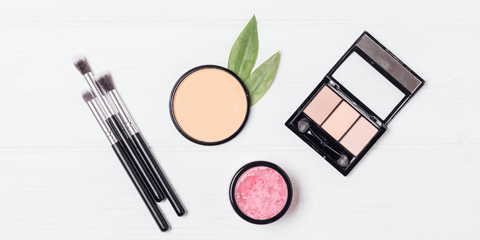
What’s Hiding In Your Makeup?
Do you know what’s in your makeup? Most people don’t. But if you take a good look at the labels of your favourite products, you might be surprised by what you find.
That’s because many of the products we use every day contain harmful ingredients that could cause serious health impacts in the short and long term. For that reason, more people are choosing to switch to natural alternatives to their favourite cosmetics brands.
Are you considering making the switch? When you’re shopping for products, here are a few of the dangerous ingredients you should watch out for:
Phthalates
Used in everything from body wash to nail polish, phthalates are added to some cosmetics to help them hold colour or scent. But phthalates can also have harmful effects on your endocrine system—the parts of your body that regulate hormone production. Studies have linked phthalate exposure with reproductive abnormalities and decreased in testosterone in men, and impaired fertility in women. There is also evidence of liver and kidney failure in children who have sucked or chewed on products containing phthalates for extended periods of time.
Parabens
Parabens are organic compounds used as preservatives in a wide variety of moisturizers, shampoos, shaving products, and makeup. Because parabens mimic estrogen in the body—and some studies have even discovered parabens in breast cancer cells—there are concerns that they could have links to some cancers.
“Fragrance”
Cosmetics companies often use ambiguous terms such as “fragrance” and “parfum” to hide harmful ingredients in their products. Since they aren’t legally required to disclose those ingredients, “fragrance” can refer to any one of thousands of chemicals, many of which have not been tested for toxicity. These unlisted items can lead to migraines, allergic reactions, asthma attacks, skin irritation, and numerous other symptoms. Be sure to check your labels with this one—even some products that are labelled “unscented” still contain “fragrance.”
Talc
Talc itself is not a carcinogen, but the concern here is about how it is mined. The mineral, which is used in eye shadows, blush, and other pressed powders, is often found near mines for asbestos, a substance which is known to cause cancer. In a few well-publicized cases, talc-based cosmetics were found to contain asbestos particles.
Formaldehyde
You’ve probably heard of this one. The chemical used to preserve dead bodies is also used in many nail polishes, hair gels, and eyelash glues to extend their shelf life. Formaldehyde is classified as a carcinogen, but there is only a cancer risk when the substance is inhaled regularly for long periods of time. That means it won’t affect anyone who occasionally paints their nails, but we should be concerned about the effects on salon workers who are consistently exposed to products containing formaldehyde.
Triclosan
Although the research isn’t conclusive, triclosan—an antimicrobial agent often found in soaps, detergents, toothpastes, and colour—has been linked to problems with hormone function. Also, because it doesn’t easily degrade, triclosan builds up in our ecosystems, causing harm to sea life.
